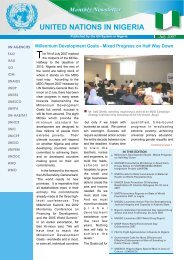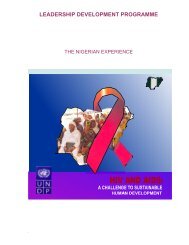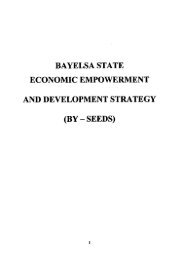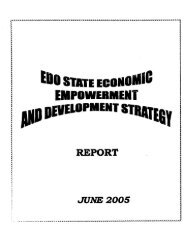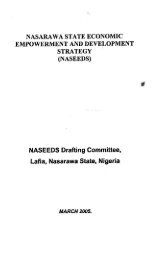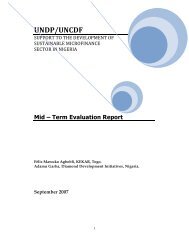Niger Delta Human Development Report - UNDP Nigeria - United ...
Niger Delta Human Development Report - UNDP Nigeria - United ...
Niger Delta Human Development Report - UNDP Nigeria - United ...
Create successful ePaper yourself
Turn your PDF publications into a flip-book with our unique Google optimized e-Paper software.
een largely limited to urban or peri-urban<br />
areas, but are now being extended to more<br />
rural localities. The reverse also takes<br />
place—more agriculture activities are being<br />
carried out in urban areas (Okali et al.<br />
2001).<br />
One of the coping mechanisms practiced<br />
by some poorer households is the seasonal<br />
migration of some members to urban areas<br />
or other localities to earn cash. This<br />
practice occurs quite extensively in the<br />
South-South and South-East geo-political<br />
zones (Olawoye et al, 2003; Okali et al,<br />
2001). According to the focus group<br />
discussions, a significant number of people<br />
from the delta work as migrant cocoa<br />
farmers in Cameroon, while others work<br />
as artisans and cyclists. Participants pointed<br />
out that the absence of reliable livelihoods<br />
in the delta has forced many youths to<br />
migrate to urban centres to make an<br />
income. Apart from depleting the rural<br />
assets for agriculture, this has been linked<br />
to the spread of HIV in the region.<br />
Social norms and local practices can also<br />
be an important source of social capital.<br />
While he was still the Deputy Governor<br />
of Bayelsa State, Dr. Goodluck Jonathan,<br />
who is now the Governor, wrote the<br />
following account of his memories as a<br />
child. He demonstrates the importance of<br />
indigenous practices:<br />
“In my community called Otuoke in Ogbia LGA<br />
of Bayelsa State, the practice when I was a child<br />
was for the community to stop fishing in the river<br />
after the traditional festival in October. The river<br />
is re-opened for fishing on the 23 rd or 24 th of<br />
December and the catch per unit effort was usually<br />
tremendous. The people, however, did not know<br />
that what they were practicing was in line with<br />
some aspects of fisheries management and<br />
conservation. In the <strong>Niger</strong> <strong>Delta</strong>, most freshwater<br />
fish spawn during the flood period when the water<br />
level is very high, overflowing into the levees. This<br />
period starts in September and reaches its peak<br />
in October. Juvenile fish fill the whole river system<br />
at this period. The closure of the river allows the<br />
juvenile fish to grow to table size by December”<br />
(Jonathan, 2004).<br />
As with many local practices that are based<br />
on traditional social beliefs, however,<br />
modern religions and current ideologies<br />
NIGER DELTA HUMAN DEVELOPMENT REPORT<br />
have discarded these norms due to their<br />
‘fetish’ undertones. Unfortunately, this has<br />
led to the loss of sound practices. A similar<br />
case is seen in the traditional preservation<br />
of ‘shrine forests’, which has now been<br />
discarded with the encroachment into the<br />
forests and the resultant loss of<br />
biodiversity. The significance of such social<br />
capital should be understood not only<br />
relative to traditional belief systems, but<br />
also in terms of the potential benefits to<br />
be derived. Good practices should be<br />
retained, even though the reasons behind<br />
them may be altered to reflect the need to<br />
preserve the natural resources that local<br />
livelihoods depend upon.<br />
Infrastructure<br />
Chapter one discussed the significance of<br />
infrastructure for human development. It<br />
is common to distinguish between three<br />
types of infrastructure: physical (e.g., roads,<br />
canals and bridges); social (e.g., health and<br />
educational facilities, and public utilities);<br />
and institutional (e.g., credit institutions and<br />
postal services). Some experts define<br />
infrastructure as the whole physical<br />
framework within which all activity and<br />
other forms of development take place.<br />
It includes housing and buildings of all<br />
kinds, roads and other forms of<br />
transportation, communications, and water<br />
and energy supplies.<br />
The provision of infrastructure will be<br />
critical to achieving sustainable livelihoods<br />
in the <strong>Niger</strong> <strong>Delta</strong>. Accessibility is a major<br />
livelihood issue, for example, given the<br />
grossly inadequate options for transport in<br />
the region. Roads are in a bad state, or<br />
simply not passable. Some communities<br />
have been practically cut off from the<br />
mainstream of activities because of this<br />
problem. They are unable to market their<br />
produce, particularly fish products, and<br />
often suffer high losses. Without health care<br />
or educational facilities within their<br />
communities, the local residents have<br />
literally no means to improve their welfare<br />
or income.<br />
For some riverine communities, there are<br />
two means of access to other parts of the<br />
delta and beyond—by water (through the<br />
rivers and creeks) or by road. In many<br />
Modern ideologies have<br />
encouraged some sound<br />
traditional practices to<br />
be discarded—this<br />
tendency should be<br />
reconsidered.<br />
Sustainable livelihoods<br />
depend on adequate<br />
roads, electricity,<br />
housing and basic social<br />
services.<br />
139



